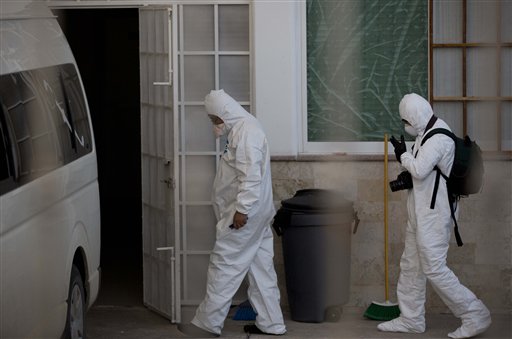 Forensic workers arrive at the morgue in Iguala Mexico, Sunday Oct. 5, 2014. Mexican forensic experts recovered 28 charred bodies from a clandestine grave on the outskirts of this city where police engaged in a deadly clash with student protesters a week ago, Guerrero state's chief prosecutor said Sunday. Authorities said the corpses were too badly damaged for immediate identification and he could not say whether any of the dead could be some of the 43 college students reported missing after the confrontation with police. (AP Photo/Eduardo Verdugo)
Forensic workers arrive at the morgue in Iguala Mexico, Sunday Oct. 5, 2014. Mexican forensic experts recovered 28 charred bodies from a clandestine grave on the outskirts of this city where police engaged in a deadly clash with student protesters a week ago, Guerrero state's chief prosecutor said Sunday. Authorities said the corpses were too badly damaged for immediate identification and he could not say whether any of the dead could be some of the 43 college students reported missing after the confrontation with police. (AP Photo/Eduardo Verdugo)IGUALA, Mexico (AP) - Revelations of mayhem, murder and mass graves shed light Monday on another deeply troubled region of Mexico, the southern state of Guerrero, where officials say city police in league with drug traffickers are suspected of carrying out an attack on students that left at least six dead and 43 missing.
As state officials worked to determine whether some of the missing students are among 28 bodies found in a clandestine grave, President Enrique Pena Nieto called the deaths "outrageous, painful and unacceptable."
Pena Nieto said he dispatched federal security forces to "find out what happened and apply the full extent of the law to those responsible."
His statement came amid rising international concern over two possible cases of mass killings involving Mexican authorities. In addition to the Iguala incident, in which 22 city police have been detained, an army unit is now under investigation and three soldiers are charged with murder in a June 30 confrontation that killed 22 suspected gang members in neighboring Mexico state.
The army originally reported that the 22 died in a gun battle after soldiers on patrol came under fire. But a witness told The Associated Press that 21 of them were killed after they surrendered.
Guerrero State Prosecutor Inaky Blanco said the bodies in the mass grave are badly damaged and genetic testing could take two weeks to two months to identify them.
Blanco said a person detained in the case had told investigators that 17 students were taken to the site outside Iguala, about 120 miles (200 kilometers) south of Mexico City, and killed there.
He said so far there was no known motive for the attack on the students. Investigators said video showed police taking away an undetermined number of students, who had gone from a rural teachers college in Ayotzinapa to the city to solicit donations.
But speculation abounded among parents and local residents as a banner appeared, signed in the name of the local drug gang Guerreros Unidos. It demanded that the 22 officers detained be released within 24 hours, and warned of consequences otherwise.
"The war has started," the banner added.
Former anti-drug prosecutor Samuel Gonzalez said it was possible that traffickers suspected the youths had been sent by a rival drug gang.
Manuel Martinez, spokesman for the students' families, denied they had any links to organized crime.
But the Ayotzinapa school has long been an ally of community police in the nearby town of Tixtla, and Martinez said that, along with the teachers union and the students, it had formed a broad front to expel cartel extortionists from the area last year.
Authorities have presented charges against 29 people in the case. Three suspects are fugitives, including Iguala's police chief.
Parts of Guerrero are controlled by vigilante-style community police forces, some believed to have ties to leftist guerrilla movements. Drug traffickers sometimes form their own pseudo-vigilante groups, and the state is torn by ancestral land conflicts, illegal logging and mining interests that create a powder keg for potential conflict.
The mass grave comprised six unmarked pits on a hillside about a mile (2 kilometers) from the nearest road. The bodies had been put on top of branches and tree trunks, which were doused with a flammable substance and set on fire.
The grave covering and the burning appeared fresh, according to an official close to the case who was not authorized to speak to the press. But there were layers of bodies separated by tarps, the official added, indicating that some might have been there for some time.
The mother of 17-year-old Luis Angel Abarca Carrillo said he had enrolled in the Ayotzinapa school to get ahead in life and not be a poor farmer like his brothers.
"But now look what they did to him," said Margarita Carrillo, 60. "He hasn't reappeared."
Mexico's National Human Rights Commission has opened its own probe of possible "serious human rights abuses" by Iguala police, and Amnesty International called on federal authorities Monday to carry out "full and thorough investigations."
